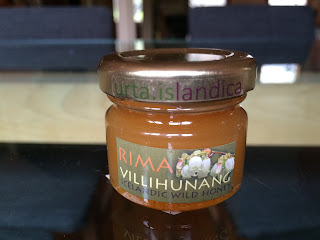 |
| Iceland & Europe |
As you can imagine, though, Iceland posses many challenges for bees and beekeepers. For one, honey bees are not native to Iceland. Bees are imported from Sweden and Norway (Buckfast bees) where they are hardy enough to withstand challenging weather conditions.
Which brings us to the weather. And it isn't so much that Iceland is cold, but windy. The wind blows incessantly which is a problem if you are bee out foraging. And the harvest season is short. Spring comes late and summers only last a few weeks, so there isn't much time for the hive population to get big enough (or strong enough) to survive the winter. To address this beekeepers use hives (polystyrene langstroth hives) that are designed to shelter bees from the windy, rainy, cold conditions. The hives also contain sensors that allow beekeepers to monitor the hive conditions remotely, giving them early warning if a colony is in trouble.
 |
| Vegetation on lava flow (September), near Husafell |
Beekeeping in Iceland is not for the faint of heart. There is a small, but by all accounts, resilient and enthusiastic group of apiarists who make up the Icelandic Beekeepers Association which was most recently reinvigorated by Egill Sigurgersson in 2000. The current iteration of the group has its beginnings in 1998 when Dr. Sigurgersson moved back to Iceland after his medical training to begin his practice in Iceland. He brought with him bees from Sweden to start a few hives. It took six months to get all the permissions needed, for licensing and certification of disease free status, and then, sadly, within two seasons all had died. He tried again, changing how he sheltered and winter fed them, but with the same results. He next tried bees from Norway and made other changes with some success. It seems that the trick for sustainability is to have at least 70-80% of the bees survive the winter.
 |
| Southern Iceland (September) |
Currently things are on the upswing for Icelandic beekeepers. There seems to be about 15-20 beekeepers across the country with about 250 hives. Most are found in the southern part of the island, near Reykjevik. They have a thriving association, and interest within and outside of Iceland. They also have a facebook page.
 |
| Gullfoss Falls |
I bought my honey at the gift shop at Gullfoss falls in September (2016). It is a tiny jar (30 mls)- perfect for a souvenir- and was about 14 Euros. It is Rima Villihunang (wild Icelandic honey) from Rimi, Grimsndsi (not sure of the spelling) in South Iceland and distributed by Urta Islandica, Hafnarfjordur. The tag on the jar says that the floral sources are wild berries, willows and heather and that the honey is raw and unrefined.
 |
| Wild Icelandic Honey (Rima Villihunang) |
